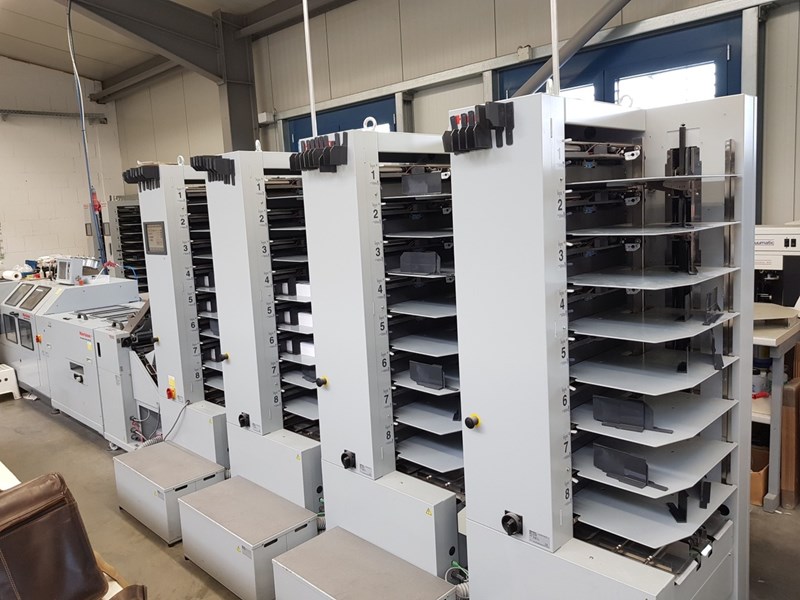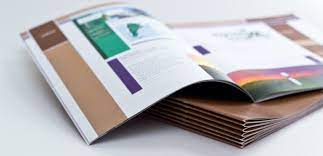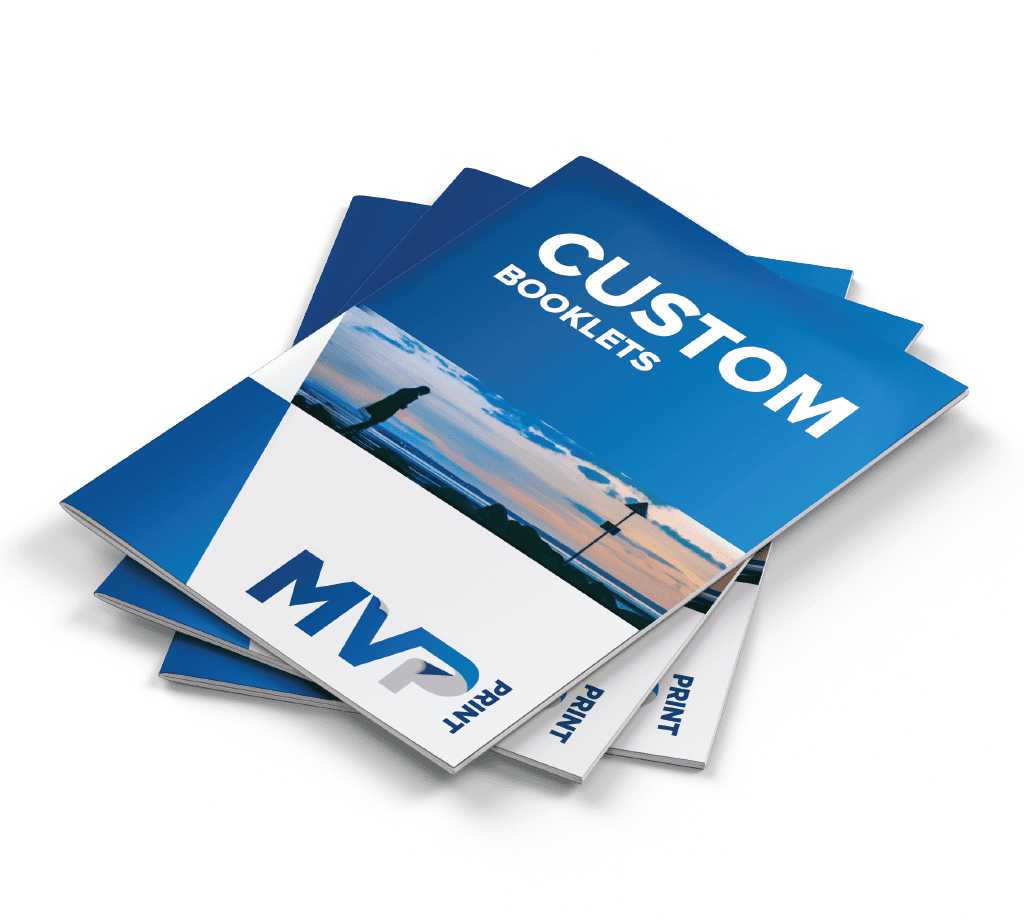
Welcome to MVP Print, your trusted printing company. Today, we’re going to give you an insider’s perspective on saddle stitching booklets. As experts in the printing industry, we understand the importance of quality and durability when it comes to booklets. Saddle stitching is a binding method that strikes the perfect balance between affordability and professionalism, making it an ideal choice for various printing needs.
When it comes to saddle stitching booklets, we pride ourselves on delivering exceptional results that leave a lasting impression on your target audience. Our team of skilled professionals is committed to producing high-quality booklets that not only meet but exceed your expectations.
Saddle stitching offers several advantages that make it a popular choice for businesses and individuals alike. Not only is it cost-effective, but it also provides a professional appearance that adds credibility to your marketing materials. With quick production times, you can count on MVP Print to meet your tight deadlines without compromising on quality.
In this article, we’ll dive deeper into the world of saddle stitching booklets. From understanding the basics of saddle stitching to comparing it with other binding techniques, we’ll explore the benefits of saddle stitched booklets for marketing materials. We’ll also provide valuable insights on planning your booklet, designing essentials, and selecting the right paper stock and cover options. Additionally, we’ll guide you through the print preparation process and highlight our commitment to quality assurance. We’ll also discuss efficient and cost-effective production for those last-minute printing needs.
At MVP Print, we believe in giving our clients the flexibility to customize their booklets to reflect their unique vision. We’ll share the various customisation and finishing options available, allowing you to add personal touches and create a truly bespoke booklet. Plus, we’ll provide strategies for printing large quantities of booklets while managing costs effectively.
Through real case studies, we’ll showcase the versatility of saddle stitching across different industries, proving its reliability in conveying messages effectively. Whether you’re in need of research materials, exhibition catalogues, school diaries, event booklets, policy documentation, or school yearbooks, saddle stitching can be the perfect solution.
We invite you to explore the possibilities of saddle stitching booklets with MVP Print. With our expertise and dedication to quality, we can transform your ideas into high-quality booklets that make a statement. Join us on this printing journey as we uncover the power of saddle stitching for your next project!
What Is Saddle Stitching and Why It’s Favoured in Printing

Saddle stitching is a popular and cost-effective method of binding booklets, including saddle stitched booklet binding, which is recognized for its straightforward and budget-friendly nature, making it an excellent choice for printing projects ranging from 8 to 76 pages. It involves folding paper sheets in half and securing them together with staples along the folded edge. This simple yet effective technique is widely favored in the printing industry due to its numerous advantages.
The Basics of Saddle Stitch Booklet Binding
Saddle stitching is a versatile booklet binding method that offers several benefits. Here’s how it works:
- The booklet is created by folding large sheets of paper in half.
- The folded pages are arranged in sequence, ensuring that the first page is the outside front cover and the last page is the outside back cover.
- Staples are inserted along the folded edge, securing the pages together and creating a finished booklet.
This straightforward process ensures that the booklet is securely bound and keeps the pages aligned.
Comparing Saddle Stitching with Other Binding Techniques
When it comes to choosing the right binding method for booklets, saddle stitching offers several advantages over other techniques like perfect binding or wire binding.
Binding Technique Advantages
- Cost-effectiveness
- Quick production time
- Ability to lay flat when opened
- Professional appearance
- Suitable for thick booklets
- Allows for printing on the spine
Wire Binding
- Easy addition or removal of pages
- 360-degree page turning
- Flat opening capability
While each binding technique has its own strengths, saddle stitching stands out for its cost-effectiveness, quick production time, and the ability to lay flat when opened. These advantages make it a preferred choice for a wide range of projects, including marketing materials and promotional brochures.
Benefits of Saddle Stitched Booklets for Marketing Materials
Saddle stitched booklets are particularly well-suited for marketing materials due to their professional and visually appealing look. Here are some key benefits:
- Cost-effectiveness: Saddle stitching is an economical binding method, making it suitable for printing large quantities of marketing materials without breaking the budget.
- Professional appearance: The clean and seamless finish of saddle stitched booklets gives them a polished and professional look that elevates the brand image.
- Quick production: Saddle stitching allows for rapid production, making it ideal for last-minute marketing campaigns or time-sensitive promotions.
These advantages make saddle stitched booklets a popular choice for businesses looking to create impactful marketing materials that effectively communicate their message to their target audience.
Planning Your Booklet from Concept to Physical Copy

When it comes to creating a saddle stitched booklet, careful planning is essential to ensure a successful outcome. Here are some key steps to help you navigate the process:
- Define Your Objectives: Start by outlining the purpose of your booklet. Is it a marketing tool, a product catalog, or an informational guide? Understanding the objective will guide your content and design decisions.
- Know Your Audience: Consider who your target audience is and what they’re looking for. Tailor your content and design elements to meet their preferences and needs. Think about their demographics, interests, and the message you want to convey.
- Gather and Organize Content: Collect all the necessary information, including text, images, and any other visual elements you plan to include in your booklet. Organize the content into sections to ensure a logical flow and easy navigation.
- Select a Color Scheme and Fonts: Choose a color scheme that aligns with your brand identity or the theme of your booklet. Consider using fonts that are legible and visually appealing. Consistency in design elements enhances the overall look and feel of your booklet.
- Design for Impact: Pay attention to the layout and visual hierarchy of your booklet. Use images, graphics, and typography effectively to engage your readers and highlight key information.
By following these steps, you can plan your booklet from concept to physical copy, ensuring a well-designed and effective communication tool.
Design Essentials for Saddle Stitching Booklets
Designing saddle stitch booklets involves careful attention to various design essentials that contribute to the overall visual appeal and effectiveness of the final product. One crucial aspect to consider is ensuring the booklet’s page count is in multiples of 4. This is necessary for the saddle stitching binding method to work effectively. To achieve this, you may need to add blank pages, possibly on the inside covers, to ensure the total number of pages aligns correctly for binding. Blank pages can play a significant role in the design and layout process, not only aiding in maintaining the correct page count but also in ensuring the booklet’s alignment and professional appearance. MVP Print, a leading printing company, provides valuable insights into these design considerations, including the strategic use of blank pages, to help clients create captivating saddle stitched booklets that leave a lasting impression.
Page Layout and Saddle Stitch Considerations
When designing a saddle stitched booklet, it is crucial to pay attention to the page layout and consider the specific requirements of saddle stitch binding. MVP Print recommends using design software like Adobe InDesign or Illustrator to set up the document properly. Ensuring that the page size matches the trimmed dimensions of the booklet is essential for accurate printing and binding results.
Arranging the content in the correct sequence is another important consideration. The first page should be the outside front cover, followed by the rest of the pages in the booklet, and ending with the outside back cover. This sequential arrangement ensures a seamless reading experience and professional presentation.
In addition, it is advisable to leave space in the margins for staples. This prevents text or images from getting too close to the folded edge, ensuring that no important content is lost during the binding process. Furthermore, adding bleed to the design allows for any potential printing or trimming variations, ensuring that the design extends to the edges of the booklet.
Creating Consistent Design Elements for Brand Identity
Establishing a consistent visual identity is essential for effective branding. When designing saddle stitched booklets, it is important to create design elements that align with the brand identity. MVP Print suggests considering factors such as color schemes, fonts, and imagery that accurately represent the brand and convey its message.
Consistency in design elements across the booklet helps create a unified and cohesive look, making the brand easily recognizable. Using the brand’s logo and incorporating its specific colors and fonts throughout the booklet reinforces brand identity and strengthens brand recognition among the target audience.
By carefully choosing design elements that reflect the brand’s unique identity, designers can create visually appealing saddle stitched booklets that captivate readers, convey the intended message, and reinforce the brand’s personality.
Saddle Stitch Design Essentials Importance Proper page layout and sequence To ensure a seamless reading experience Leaving space for staples in the margins To prevent important content from being lost during binding Adding bleed to the design To accommodate any printing or trimming variations Consistent use of brand colors, fonts, and imagery To reinforce brand identity and strengthen recognition
Saddle Stitching Booklets Page Order and Setup

The page order of saddle stitched booklets follows a specific arrangement to ensure a seamless reading experience. Understanding the correct page order and setup is crucial for designers and printers to deliver high-quality booklets. Let’s delve into the page order and setup requirements for saddle stitched booklets.
Page Order:
The page order for saddle stitched booklets is as follows:
- Outside Front Cover
- Inside Front Cover
- Inside Back Cover
- Outside Back Cover
If the booklet is self-cover, meaning the cover is made from the same paper as the inside pages, it can be provided as a single-scrolled PDF. However, if a hard cover or a cover with a different weight than the inner pages is desired, separate files are required for the cover artwork and inner pages.
It is important to note that the page count of the booklet should be in multiples of four for proper saddle stitching. This is because each sheet of paper is folded in half to create four pages. Designers should ensure that the total number of pages is divisible by four to avoid any issues during printing and binding.
Additionally, designers should extend their design to the bleed area and carefully review the content for any errors before finalizing everything. This includes checking for typos, inconsistencies, and alignment issues to ensure a polished and professional booklet.
Table:
Saddle Stitched Booklets Page Order and Setup Page Number Page Content 1 Outside Front Cover 2 Inside Front Cover 3 Inside Back Cover 4 Outside Back Cover
Table: Saddle Stitched Booklets Page Order and Setup
This table illustrates the page order for saddle stitched booklets. It provides a clear visual representation of how the pages should be arranged, starting with the outside front cover and ending with the outside back cover.
By following the correct page order and setup requirements, designers and printers can ensure that saddle stitched booklets are organized and assembled accurately. This meticulous attention to detail guarantees a professional and visually appealing finished product that meets the expectations of clients and readers alike.
Understanding Paper Stock and Cover Options for Your Booklet
When it comes to creating high-quality saddle stitched booklets, selecting the right paper stock and cover options is essential. These choices not only impact the durability of your booklet but also contribute to its overall aesthetic appeal. MVP Print, a trusted printing company, provides expert guidance on making these important decisions. They offer an extensive range of self-cover and hard cover options, ensuring your booklet’s cover printed aspect meets your specific needs. Self-cover booklets have all pages, including the cover, printed on the same paper type and weight, offering a uniform look and feel. In contrast, hard cover booklets feature the cover printed on a heavier paper weight than the internal pages, enhancing the booklet’s durability and premium feel.
Selecting the Right Paper Stock for Durability
Choosing the appropriate paper stock is crucial in ensuring the longevity and durability of your saddle stitched booklet. Factors such as weight, texture, and finish should be taken into consideration. Opting for a heavier paper stock enhances the sturdiness of your booklet, making it more resistant to wear and tear. Additionally, selecting a paper with a smooth or matte finish can add a touch of sophistication to your booklet’s appearance.
At MVP Print, we offer a wide range of paper stock options to suit your specific requirements. Whether you prefer a sleek and professional look or a more textured and tactile feel, our knowledgeable team can help you find the perfect paper stock that aligns with the purpose and style of your booklet.
Hard Cover vs Self Cover Options in Saddle Stitching
In addition to paper stock, the cover options for your saddle stitched booklet also deserve careful consideration. Two common options are hard covers and self covers.
Hard covers provide enhanced durability and protection for your booklet. They consist of a thicker, more rigid material that helps safeguard the inner pages from damage. If you’re looking to create a premium and long-lasting booklet that can withstand frequent handling, a hard cover is an excellent choice. It adds a touch of elegance to your booklet and gives it a more substantial and professional feel.
On the other hand, self covers use the same paper stock as the inner pages of your booklet. This creates a cohesive and uniform look throughout the entire piece. Self covers are a popular option for booklets where a consistent design and aesthetic is desired.
Table: Paper Stock and Cover Options
Paper Stock Durability Aesthetic Appeal Lightweight Less durable Affordable option with a versatile range of finishes Heavyweight High durability Provides a substantial and premium feel Smooth or Matte Finish Increased resistance to wear and tear Elegant and professional appearance Self Cover Consistent design throughout the booklet Uniform look and feel Hard Cover Enhanced durability and protection Premium and professional feel
By understanding the various paper stock and cover options available, you can make informed decisions that align with your booklet’s purpose, durability requirements, and aesthetic preferences. MVP Print is here to assist you in selecting the right paper stock and cover options that will elevate the impact and longevity of your saddle stitched booklet.
Print Preparation and Quality Assurance with MVP Print

MVP Print is dedicated to ensuring a smooth printing process for their clients through their comprehensive print preparation and quality assurance services. From design approval to prepress setup, MVP Print guides clients every step of the way. A crucial part of this process involves a meticulous review of the printed pages to ensure their quality and consistency before proceeding to the final print run. This step guarantees the successful production of high-quality saddle stitched booklets, with attention to detail in every aspect from paper type to binding methods and booklet terminology.
From Design Approval to Prepress Setup
Once the design is finalized and approved by the client, MVP Print takes charge of the prepress setup. This involves preparing the digital files for printing, ensuring that they meet the necessary specifications and requirements.
During the prepress setup, MVP Print pays meticulous attention to the details, such as bleeds and margins, to ensure that the final product turns out exactly as intended. They make sure that all design elements and content are accurately represented in the printing process, resulting in a visually appealing and professional booklet.
Colour Proofing and Hard Copy Prototyping
Colour proofing is an essential step in the print preparation process. MVP Print provides clients with the opportunity to review and approve the colour accuracy of their booklet before printing the main run. This ensures that the colours match the client’s expectations and maintains brand consistency throughout the booklet.
To further ensure client satisfaction, MVP Print offers hard copy prototyping, providing a physical sample of the final product for review and approval. This allows clients to have a hands-on experience with their booklet, making any necessary adjustments or corrections before proceeding with the full printing process.
At every stage of the print preparation process, MVP Print conducts thorough quality checks and applies their expertise to ensure that each booklet meets the highest standards of quality and precision.
Print Preparation Process Quality Assurance Measures Design approval Reviewing design accuracy and ensuring client satisfaction Prepress setup Attention to detail in file preparation, including bleeds and margins Colour proofing Confirming colour accuracy and maintaining brand consistency Hard copy prototyping Providing a physical sample for client review and approval Quality checks Meticulous inspections to ensure high standards of quality
Efficient and Cost-Effective Production for Last-Minute Needs
When it comes to last-minute printing needs, efficiency and cost-effectiveness are crucial. At MVP Print, we understand the importance of delivering high-quality saddle stitched booklets within tight timelines without compromising on quality. Our efficient production processes ensure that clients receive their booklets on time, even for urgent printing requirements.
Whether you need a small or large quantity order, our team leverages their expertise in saddle stitching to provide quick and cost-effective solutions. We have the capability to handle fast turnaround times without sacrificing the quality of the final product. Our streamlined production workflow allows us to meet your last-minute printing needs efficiently and effectively.
With our efficient production processes, we ensure that every step of the printing process is optimized for speed and accuracy. From file preparation to printing and finishing, we employ state-of-the-art technology and skilled professionals to maximize productivity and minimize production time.
Our commitment to cost-effectiveness means that we provide competitive pricing for our saddle stitched booklets without compromising on quality. We understand the importance of budget considerations, especially for last-minute printing needs, and strive to offer affordable solutions that meet your requirements.
At MVP Print, we pride ourselves on our ability to deliver efficient and cost-effective production for last-minute printing needs. With our expertise in saddle stitching and dedication to quality, you can trust us to meet your deadlines and exceed your expectations. Contact us today to discuss your printing requirements and experience the benefits of our efficient production processes.
Customisation and Finishing Options in Saddle Stitched Booklets
Saddle stitched booklets offer a range of customisation and finishing options to suit the unique needs and preferences of clients. MVP Print provides an extensive range of customisation features, allowing clients to create booklets that truly represent their brand and message. These customisation options include:
Choose From an Extensive Range of Customisation Features
- Cover materials: Clients can choose from a variety of cover materials, including high-quality paper stocks, cardstocks, or specialty materials like leather or fabric.
- Finishes: Booklets can be finished with different coatings to enhance their appearance and durability. Options include glossy, matte, or soft-touch finishes.
- Personalised details: Clients have the option to add personal touches to their booklets. This can include embossed or debossed logos, custom die-cut shapes, or foil stamping.
With these customisation options, clients can create booklets that align with their branding and stand out from competitors.
Adding Personal Finishes: A Handcrafted Approach
Personal finishes add a unique and handcrafted touch to saddle stitched booklets. MVP Print offers a range of personal finishes that clients can choose from to add that extra level of customization:
Personal Finishes Description Colored pins or threads Add a pop of color to the booklet by including colored pins or threads that complement the design. Ribbons or bows For an elegant touch, ribbons or bows can be added to the booklets, giving them a sophisticated look. Handwritten notes Personalise each booklet by including handwritten notes or signatures, creating a more intimate connection with the recipient.
These personal finishes add character and make each booklet feel unique and special. They are perfect for client gifts, special events, or limited edition booklets.
Strategies for Printing Large Quantities of Booklets
When it comes to printing large quantities of saddle stitched booklets, careful planning is essential. MVP Print offers a range of strategies to help clients efficiently meet their booklet printing needs while managing costs effectively.
Evaluating Quantity for Printing and Potential Reprints
Before starting the printing process, it is crucial to evaluate the quantity of booklets needed. MVP Print recommends carefully considering the expected demand and ordering slightly more booklets than required to account for any future needs or unexpected increases in demand.
By evaluating the quantity needed and ordering strategically, clients can avoid the inconvenience and cost of additional reprints due to insufficient quantities.
Managing Setup Costs for Economical Reorders
Another important consideration when printing large quantities of booklets is managing setup costs for potential reorders. MVP Print provides guidance on cost-effective reorders, ensuring that clients get the best value for their investment.
By planning for reorders and efficiently managing setup costs, clients can save money and streamline the printing process for repeated orders.
Whether it’s for a single large order or multiple reorders, MVP Print’s expertise in printing strategies allows them to deliver high-quality saddle stitched booklets while optimizing costs.
Case Studies: Saddle Stitching Versatility Across Various Industries

MVP Print showcases the versatility of saddle stitching through case studies in various industries. These case studies demonstrate how saddle stitched booklets are used for different purposes, catering to the unique requirements of each industry.
Research Materials: In the academic sector, saddle stitching is commonly used to bind research materials such as reports, journals, and dissertations. This binding method ensures that important research findings are presented professionally and securely.
Exhibition Catalogues: Saddle stitched booklets are popular for showcasing artwork and exhibitions. The durability and flexibility of the saddle stitch binding make it ideal for catalogues that need to withstand frequent handling and display stunning visuals.
School Diaries: Schools often utilize saddle stitching to create diaries for students. These diaries contain academic schedules, important dates, and interactive sections, providing a practical and organized resource for students to keep track of their studies.
Event Booklets: Saddle stitched booklets are commonly used to showcase event programs, speaker profiles, and sponsorship details. Event organizers find saddle stitching to be a cost-effective and visually appealing solution for distributing essential information to attendees.
Policy Documentation: Many organizations use saddle stitched booklets to present policy documents and guidelines. The compact and professional format of saddle stitched booklets ensures that important policies are easily accessible and effectively communicated to employees and stakeholders.
School Yearbooks: Saddle stitched booklets are frequently used to create school yearbooks, capturing memories and commemorating achievements. This binding method allows for easy flipping through the pages and provides a lasting keepsake for students and their families.
These case studies highlight the effectiveness of saddle stitching across diverse industries, proving its flexibility and reliability. MVP Print’s expertise in saddle stitching enables them to provide creative and effective solutions for clients seeking to utilize this binding method in their own projects.
Conclusion
In conclusion, saddle stitching is a reliable and cost-effective binding method that offers numerous benefits for booklets. MVP Print emphasizes the quality and durability of saddle stitched booklets, making them an excellent choice for marketing materials and promotional brochures. By opting for saddle stitching, clients can enjoy the advantages of professional appearance, quick production, and affordability.
Proper planning, understanding design essentials, and selecting the right paper stock and cover options are crucial for creating visually appealing and impactful saddle stitched booklets. MVP Print’s print preparation and quality assurance services ensure a seamless printing process, guaranteeing that each booklet meets the highest standards. They also offer efficient and cost-effective production solutions for last-minute printing needs.
With a wide range of customisation and finishing options, saddle stitched booklets can be tailored to suit the unique vision and brand identity of each client. From choosing the right colors, textures, and finishes, to adding personal details and accents, saddle stitching allows for creative expression and customization.
With strategic printing strategies, clients can confidently print large quantities of saddle stitched booklets while managing costs effectively. Whether for research materials, exhibition catalogues, or school yearbooks, saddle stitching has proven its versatility in various industries, making it a reliable choice for showcasing content and conveying messages effectively.
MVP Print encourages clients to explore the possibilities of saddle stitching for their printing projects and transform their ideas into high-quality, durable saddle stitched booklets that leave a lasting impression on their target audience.
FAQ
What is saddle stitching and why is it favored in printing?
Saddle stitching is a method of binding booklets by folding paper sheets in half and securing them together with staples along the folded edge. It is favored in printing due to its cost-effectiveness and quick production time.
What are the benefits of saddle stitched booklets for marketing materials?
Saddle stitched booklets have a professional and visually appealing look, making them ideal for marketing materials. They are also affordable and can lay flat when opened, providing a convenient reading experience for the target audience.
How should I plan my booklet from concept to physical copy?
When planning your booklet, start by outlining the objectives and tailoring the content and design to meet the preferences of your target audience. Gather all necessary information and organize the content into sections. Select a color scheme, fonts, and images that align with your brand identity and message.
What are the design essentials for saddle stitching booklets?
When designing saddle stitched booklets, pay attention to page layout and saddle stitch considerations. Set up the document using design software and ensure the page size matches the trimmed dimensions of the booklet. Arrange the content in the correct sequence and add bleed and space for staples. Create consistent design elements that reflect your brand identity.
What is the page order and setup process for saddle stitched booklets?
The page order of saddle stitched booklets follows a specific arrangement: outside front cover, inside front cover, inside back cover, and outside back cover. Ensure that the page count is in multiples of four for proper saddle stitching. Extend your design to the bleed area and review the content for any errors before finalizing everything.
What paper stock and cover options are available for saddle stitched booklets?
When selecting paper stock, consider factors such as weight, texture, and finish to suit the purpose of your booklet. For covers, you can choose between hard covers, which provide added durability and a premium feel, or self covers, which use the same paper stock as the inner pages for a cohesive look.
How does MVP Print ensure a seamless printing process and quality assurance?
MVP Print provides print preparation and quality assurance services, guiding clients through the necessary steps for successful printing. This includes color proofing to confirm color accuracy and hard copy prototyping to provide a sample of the final product before printing the main run. They conduct quality checks to ensure each booklet meets client requirements.
How does MVP Print handle last-minute printing needs?
MVP Print delivers fast turnaround times without compromising on quality, making them suitable for last-minute printing requirements. They have efficient production processes that ensure clients receive their saddle stitched booklets on time, even for urgent orders.
What customization and finishing options are available for saddle stitched booklets?
MVP Print offers an extensive range of customization features, including options for cover materials, finishes, and personalized details. Clients can choose from glossy, matte, or textured covers and add personal finishes like colored pins or threads to enhance the visual appeal of their booklets.
How can I manage printing large quantities of booklets while controlling costs?
It is important to carefully evaluate your printing needs and order slightly more booklets than required to account for future demands. MVP Print provides guidance on managing setup costs for economical reorders, saving clients money and efficiently meeting their booklet printing needs.
How does saddle stitching prove its versatility across various industries?
Saddle stitching can be creatively and effectively applied in various industries, as demonstrated through case studies. It is used for purposes such as research materials, exhibition catalogues, school diaries, event booklets, policy documentation, and school yearbooks, offering inspiration and ideas for clients.








